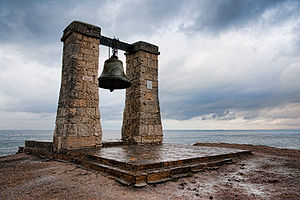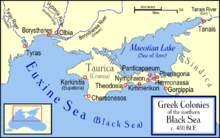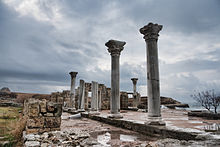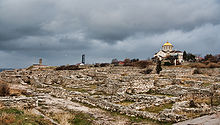- Chersonesus Taurica
-
Chersonesus Taurica
Χερσόνησος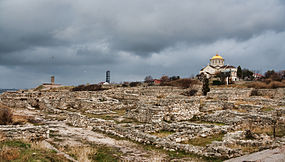
St Vladimir's Cathedral overlooks the extensive excavations of Chersonesus. Alternate name Корсунь Location Gagarin Raion, Sevastopol Region Crimea Coordinates 44°36'39"N 33°29'28"E Type Greek city-colony Part of National Preserve "Khersones Tavriysky" History Builder Settlers from Heraclea Pontica Founded 6th century BC Cultures Classical Greece Site notes Excavation dates 1827 (Russian government) Public access tourist attraction Chersonesus Taurica (Greek: Χερσόνησος, Chersonēsos; Latin: Chersonesus; Byzantine Greek: Χερσών; Old East Slavic: Корсунь, Korsun; Ukrainian and Russian: Херсонес, Khersones; also transliterated as Chersonese, Chersonesos, Cherson) is an ancient Greek colony founded approximately 2,500 years ago in the southwestern part of Crimea, known then as Taurica. The colony was established in the 6th century BC by settlers from Heraclea Pontica.
The ancient city is located on the shore of the Black Sea at the outskirts of Sevastopol on the Crimean Peninsula of Ukraine, where it is referred to as Khersones. It has been nicknamed the "Ukrainian Pompeii" and "Russian Troy". The site is now part of the National Historical-Archeological Museum-Zapovednik of the Ukrainian Khersones Tavriysky. The name "Chersonesos" in Greek means "peninsula", and aptly describes the site on which the colony was established. It should not be confused with the Tauric Chersonese, the name often applied to the whole of the southern Crimea along with Taurica.
During much of the classical period Chersonesus Taurica was a democracy ruled by a group of elected archons and a council called the Damiorgi. As time passed the government grew more oligarchic, with power concentrated in the hands of the archons. A form of oath sworn by all the citizens since the 3rd century BC has survived to the present day.
Contents
History
Antiquity
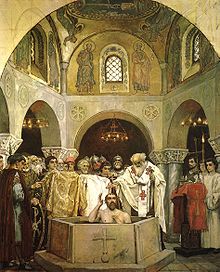 Viktor Vasnetsov: Baptism of Saint Prince Vladimir in Korsun.
Viktor Vasnetsov: Baptism of Saint Prince Vladimir in Korsun.
List of Kings of Cimmerian Bosporus According to Diodorus Siculus (xii. 31) the locality was governed from 480 BC to 438 BC by a line called the Archaeanactidae, probably a ruling family, who gave place to a tyrant Spartocus (438 BC - 431 BC), apparently a Thracian. He founded a dynasty which seems to have endured until c. 110 BC. The Spartocids have left many inscriptions which indicate that the earlier members of the house ruled as archons of the Greek cities and kings of various native tribes, notably the Sindi of the island district and other branches of the Maeotae. Unfortunately, the texts, inscriptions and coins do not supply sufficient material for a complete list of these monarchs.
Bosporan Phiale, 4th century BC Satyrus (431 BC - 387 BC), the successor of Spartocus, established his rule over the whole district, adding Nymphaeum to his dominions and laying siege to Theodosia, which was a serious commercial rival because of its ice-free port and proximity to the grain fields of eastern Crimea. It was reserved for his son Leucon (387 BC - 347 BC) to take this city. He was succeeded by his two sons conjointly, Spartocus II, and Paerisades; the former died in 342 and his brother reigned alone until 310. Then followed a civil war in which Satyrus defeated his yonger brother Eumelus at the Battle of the River Thatis in 310 BC but then was killed giving Eumelus the throne.
His successor was Spartocus III (303 BC - 283 BC) and after him Paerisades II. Succeeding princes repeated the family names, but we cannot assign them any certain order. We know only that the last of them, Paerisades V, unable to make headway against the power of the natives, in 108 BC called in the help of Diophantus, general of Mithridates the Great of Pontus, promising to hand over his kingdom to that prince. He was slain by a Scythian named Saumacus who led a rebellion against him.
The house of Spartocus was well known as a line of enlightened and wise princes; although Greek opinion could not deny that they were, strictly speaking, tyrants, they are always described as dynasts. They maintained close relations with Athens, their best customers for the Bosporan grain export, of which Leucon I set the staple at Theodosia, where the Attic ships were allowed special privileges. The Attic orators make numerous references to this. In return the Athenians granted him Athenian citizenship and set up decrees in honour of him and his sons.
In the 1st century BC, after his defeat by Pompey in 63 BC, Mithradates VI (King of Pontus) fled with a small army from Colchis (modern Georgia) over the Caucausus Mountains to Crimea and made plans to raise yet another army to take on the Romans. His eldest living son, Machares, viceroy of Cimmerian Bosporus, was unwilling to aid his father. Mithradates had Machares killed, and Mithradates took the throne of the Bosporan Kingdom. Mithradates then ordered the conscriptions and preparations for war. But in 63 BC, Pharnaces II, his younger son, led a rebellion against his father, joined by Roman exiles in the core of Mithridates' Pontic army. Mithradates withdrew to the citadel in Panticapaeum, where he committed suicide. Pompey the Great buried Mithradates in the rock-cut tombs of his ancestors in Amasia, the old capital of Pontus.
Roman Bosphoran Kingdom
The "Regnum Bosphoranum" during Roman emperor Trajan conquestsMithridates entrusted the Bosporus Cimmerius to his son Machares, who, however, deserted to the Romans. But even when driven out of his own kingdom by Pompey, Mithridates was strong enough to regain the Cimmerian Bosporus, and Machares slew himself. Subsequently the Bosporans again rose in revolt under Pharnaces, another of the old king's sons. After the death of Mithridates (63 BC), this Pharnaces (63 BC - 47 BC) made his submission to Pompey, then tried to regain his dominion during the civil war, but was defeated by Caesar at Zela and later killed by a former governor of his.
A pretender, Asander married his daughter Dynamis, and in spite of Roman nominees ruled as archon, and later as king, until 17 BC. After his death, Dynamis was compelled to marry a Roman usurper called Scribonius, but the Romans under Agrippa interfered and set Polemon I of Pontus (16 BC - 8 BC) in his place. Dynamis died in 14 BC and Polemon ruled until 8 BC. After Polemon's death, Tiberius Julius Aspurgus, son of Dynamis and Asander, succeeded Polemon. His Bosphoran kingdom was a "Client State" of the Roman Empire, helped by Roman garrisons.
Ruins of Panticapaeum, modern Kerch, the capital of the Bosporan Kingdom.Tiberius Julius Aspurgus (8 BC - 38) founded a line of kings which endured with certain interruptions until 341 AD. Originally called Aspurgus, he adopted the names "Tiberius Augustus" because he enjoyed the patronage of the first two Roman Emperors, Augustus and Tiberius. All of the following kings adopted these two Roman names followed by a third name, mostly of Pontic and Thracian origin (such as Kotys, Rhescuporis and Rhoemetalces), but also of local origin (such as Sauromates, Eupator, Ininthimeus, Pharsanzes, Synges, Terianes, Theothorses and Rhadamsades).
As the dynasty descended from King Mithridates VI of Pontus through Aspurgus, the kings adopted the "Pontic era" introduced by Mithridates, which started with 297 BC; this era was used to date coins. Bosporan kings struck coinage throughout the kingdom period, which included gold staters bearing portraits of the respective Roman Emperors. However this coinage increasing became debased in the 3rd century. Hence, we know their names and dates fairly well, though scarcely any events of their reigns are recorded. Their kingdom covered the eastern half of Crimea and the Taman peninsula, and extended along the east coast of the Maeotian marshes to Tanais at the mouth of the Don, a great market for trade with the interior.
They carried on a perpetual war with the native tribes, and in this were supported by their Roman suzerains, who even lent the assistance of garrison and fleet. In 63 AD for unknown reasons, the Roman Emperor Nero disposed Cotys (Bosphoran king) from his throne: the Bosporan Kingdom was a Roman Province from 63-68. In 68 AD, the new Roman Emperor Galba had restored the Bosporan Kingdom to Tiberius Julius Rhescuporis I.
At times rival kings of some other races arose and probably produced some disorganization. At one of these periods (255) the Goths and Borani were able to seize Bosporan shipping and raid the shores of Anatolia.
With the coins of the last King Tiberius Julius Rhescuporis VI, in 341 AD, materials for a connected history of the Bosporus Cimmerius come to an end. The kingdom probably succumbed to the Huns, who defeated the nearby Alans in 375/376 AD and moved rapidly westwards bringing destruction in their wake.
In the late 2nd century BC Chersonesus became a dependency of the Bosporan Kingdom. It was subject to Rome from the middle of the 1st century BC until the 370s AD, when it was captured by the Huns.
Byzantine Era
 The Saint Vladimir Cathedral in Chersonesus was built in the 19th century in the Byzantine Revival style.
The Saint Vladimir Cathedral in Chersonesus was built in the 19th century in the Byzantine Revival style.
It became a Byzantine possession during the Early Middle Ages and withstood a siege by the Göktürks in 581. Byzantine rule was slight: there was a small imperial garrison more for the town's protection than for its control. It was useful to Byzantium in two ways: as an observation point to watch the barbarian tribes, and its isolation made it a popular place of exile for those who angered the Roman and later Byzantine governments. Among its more famous "inmates" were Pope Clement I and Pope Martin I, and the deposed Byzantine Emperor Justinian II. According to Theophanes the Confessor and others, Chersonesus was the residence of a Khazar governor (tudun) in the late 7th century.
In 833 Emperor Theophilus sent the nobleman Petronas Kamateros, who had recently overseen the construction of the Khazar fortress of Sarkel, to take direct control over the city and its environs, establishing the theme of Klimata/Cherson. It remained in Byzantine hands until the 980s, when it reportedly fell to Kiev. Vladimir the Great agreed to evacuate the fortress only if Basil II's sister Anna Porphyrogeneta would be given him in marriage. The demand caused a scandal in Constantinople, as imperial princesses had never been married to non-Greeks before. As a pre-condition for the marriage settlement, Vladimir was baptized here in 988, thus paving the way to the Baptism of Kievan Rus'. Thereafter Korsun' was evacuated.
Since this campaign is not recorded in Greek sources, historians have suggested that this account actually refers to the events of the Rus'-Byzantine War (1043) and to a different Vladimir. In fact, most valuables looted by the Slavs in Korsun' made their way to Novgorod (perhaps by way of Ioakim Korsunianin, the first Novgorodian bishop, as his surname indicates ties to Korsun), where they were preserved in the Cathedral of Holy Wisdom until the 20th century. One of the most interesting items from this "Korsun Treasure" is the copper Korsun Gate, supposedly captured by the Novgorodians in Korsun' and now part of the St. Sophia Cathedral.
After the Fourth Crusade Chersonesus became dependent on the Empire of Trebizond, and then fell under Genoese control in the early 13th century. In 1299, the town was sacked by the armies of Nogai Khan. A century later it was destroyed by Edigu and was permanently abandoned. In the late 19th century, St Vladimir's Cathedral (completed 1892) was built on a small hill overlooking the site; designed in Byzantine style, it was intended to commemorate the site of Vladimir's baptism.
Archaeological site
Chersonesus' ancient ruins are presently located in one of Sevastopol's suburbs. They were excavated by the Russian government, starting from 1827. They are today a popular tourist attraction, protected by the state as an archaeological park.
The buildings mix influences of Greek, Roman and Byzantine culture. The defensive wall is hundreds of meters long. Buildings include a Roman amphitheatre and a Greek temple.
The largest portion of the site is "Chora", several square kilometres of ancient but now barren farmland, with remains of wine presses and defensive towers. According to archaeologists, the evidence suggests that the locals were paid to do the farm work instead of being enslaved.
The excavated tombstones hint at burial practices that were different from the Greek ones. Each stone marks the tomb of an individual, instead of the whole family and the decorations include only objects like sashes and weapons, instead of burial statues. Over half of the tombs archaeologists have found have bones of children. Burned remnants suggest that the city was plundered and destroyed.
In 2007 Chersonesus tied for fifth in the Seven Wonders of Ukraine poll.
On February 13, 2009 Ukrainian Defence Minister Yuriy Yekhanurov called on Russia's Black Sea naval fleet to move its automobile depot from the site to another place. The location of the Russian Black Sea naval fleet's automobile depot is one of the obstacles to the inclusion of the reserve on UNESCO's list of world heritage sites.[1]
Current studies
The Institute of Classical Archaeology of the University of Texas at Austin and the local Archaeological Park has investigated the site since 1992. The Ukrainian government has included the site on its tentative World Heritage List. The site, however, is in danger of further urban encroachment and coastal erosion.
Threats to Chersonesus
The encroachment of modern building in and around the ancient archaeological site, coupled with a lack of funding to prevent such development pressures, has left the site of Chersonesus firmly at risk.[2]
In an October 2010 report titled Saving Our Vanishing Heritage, Global Heritage Fund identified Chersonesus as one of 12 worldwide sites most "On the Verge" of irreparable loss and destruction, citing insufficient management and development pressures as primary causes.[3]
See also
- List of traditional Greek place names
- Odessa Numismatics Museum having on display coins of Chersonesus
- The bell of Chersonesus
References
- ^ Yekhanurov Calls On Russia's Black Sea Naval Fleet To Move Its Automobile Depot From Khersones Tavriiskyi National Reserve, Ukrainian News Agency (February 13, 2009)
- ^ "Managing the Archaeological Heritage at the National Preserve of Tauric Chersonesos: Problems and Perspectives". Ukrainian Museum. October 2006. http://www.ukrainianmuseum.org/news_061001chersonesos.html.
- ^ http://globalheritagefund.org/index.php/what_we_do/sites_on_the_verge/
References and further reading
- Anokhin, V.A. The Coinage of Chersonesus: IV century B.C.–XII century A.D.. Oxford : British Archaeological Reports, 1980 (paperback, ISBN 086054074X).
- Carter, Joseph Coleman; Crawford, Melba; Lehman, Paul; Nikolaenko, Galina; Trelogan, Jessica. "The Chora of Chersonesos in Crimea, Ukraine", American Journal of Archaeology, Vol. 104, No. 4. (2000), pp. 707–741.
- Carter, Joseph Coleman; Mack, Glenn Randall. Crimean Chersonesos: City, Chora, Museum, and Environs. Austin, TX: David Brown Book Company, 2003 (paperback, ISBN 0970887922).
- Kozelsky, Mara. "Ruins into Relics: The Monument to Saint Vladimir on the Excavations of Chersonesos, 1827–57", The Russian Review, Vol. 63, No. 4. (2004), pp. 655–672.
- Norwich, John Julius. Byzantium: The Early Centuries. New York: Alfred A. Knopf, 1989 (hardcover, ISBN 0-394-53778-5).
- Saprykin, S.Yu. Heracleia Pontica and Tauric Chersonesus before Roman domination: (VI–I centuries B.C.). Amsterdam: A.M. Hakkert, 1997 (ISBN 9025611095).
External links
- University of Texas at Austin Institute of Classical Archaeology Chersonesos project
- Bulletin of the Odessa Numismatics Museum
- National Preserve of Tauric Chersonesos, Sevastopol
- Cherson on Regnal Chronologies
- Brief History of Antique Cities of Tauria and Their Coinage.
- Panorams of Chersonesos - (Russian)
- Photo of Chersonesos - (Russian)
- High resolution image of antique map of this region
- Explore Chersonesos with Google Earth on Global Heritage Network
Sofiyivsky Park · Kiev Pechersk Lavra · Kamianets-Podilskyi Complex · Khortytsia · Chersonesos · Saint Sophia Cathedral · Khotyn Fortress
North Pontic Greek colonies Tyras · Olbia · Borysthenes · Eupatoria · Chersonesos · Charax · Theodosia · Kimmerikon · Nymphaion · Tyritake · Panticapaeum · Myrmekion · Kepoi · Phanagoria · Hermonassa · Gorgippia · Pityus · Dioscurias · Tanais
 Categories:
Categories:- Ancient Greek cities
- Pontic Greeks
- Sevastopol
- Archaeological sites in Ukraine
- Khazar towns
- Bosporan Kingdom
- Megarian colonies
- Greek colonies in Crimea
- Ruins in Ukraine
- Populated places established in the 6th century BC
- Former populated places in Eastern Europe
Wikimedia Foundation. 2010.

